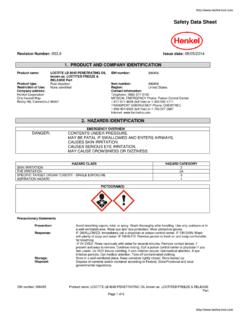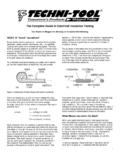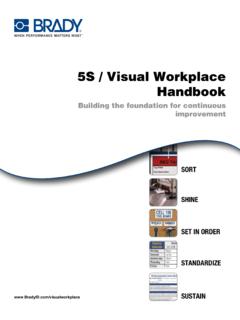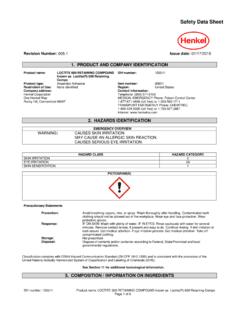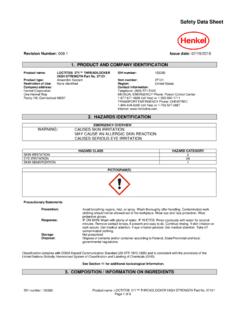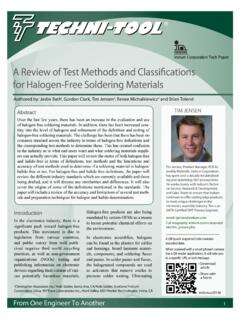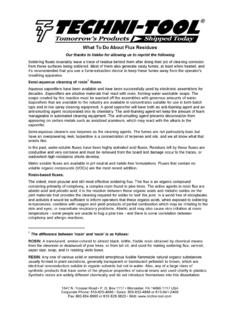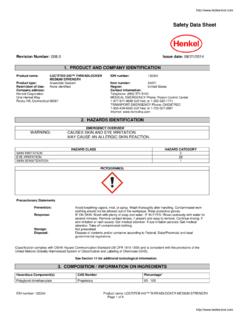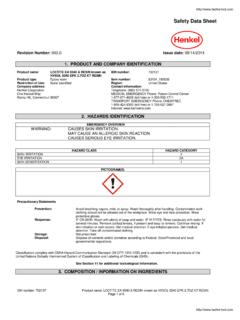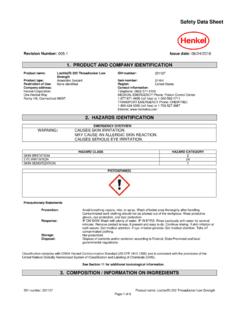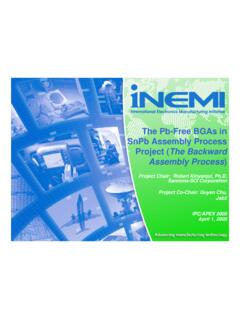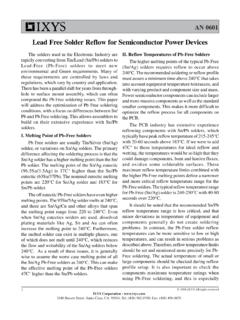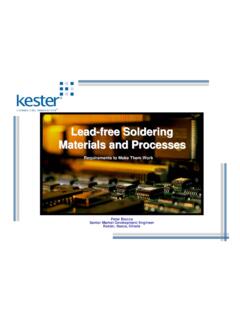Transcription of Kester - Lead-free SMT Soldering Defects How to Prevent …
1 1547 N. Trooper Road P. O. Box 1117 Worcester, PA 19490-1117 USA Corporate Phone: 610-825-4990 Sales: 800-832-4866 or 610-941-2400 Fax: 800-854-8665 or 610-828-5623 Web: Lead-free SMT Soldering Defects How to Prevent Them Our thanks to Kester for allowing us to reprint the following article. By Peter Biocca, Key Accounts Technical Manager, Kester Tin-Silver-Copper alloys are the primary choice for Lead-free SMT assembly. Although there are other options available such as alloys containing bismuth or indium and other elements, tin-silver-copper solders, also known as SAC alloys are by far the most popular. They are used by approximately 65% of users, as last surveyed in 2011.
2 The Lead-free SMT process differs from a 63/37 process in numerous ways. A good understanding of these differences when using SAC alloys, will enable process engineers to bring about the necessary changes to the SMT process and reduce Soldering Defects , increase Lead-free assembly reliability and maintain production yields. Often when a manufacturer transitions to Lead-free Soldering an increase in Defects is noticed. This is often the result of a not properly implemented process. A well-defined, optimized and controlled Lead-free process will not augment defect rates. The main differences between a leaded and Lead-free SMT process are summarized below: solder physical properties, melting point, surface tension, oxidation potential, metallurgy and metal leaching potential Higher peak temperatures Higher preheat temperatures Lead-free finishes for boards and components (preferred) solder cosmetics and surface effects Solderability differences such as speed of wetting and spread Less self-centering or alignment of components The liquidus temperature of SAC alloys is 217-220 C; this is about 34 C above the melting point of eutectic 63/37.
3 This higher melting range requires peak temperatures to achieve wetting and wicking to be in the range of 235-245 C. Lower peak temperatures can be used with SAC solders such as 229 C. This lower peak temperature often can only be used for boards with lower overall thermal masses or assemblies, which do not have a large thermal mass differential across the board. This lower peak temperature may also require extended times above liquidus (TAL). Higher reflow profile temperatures will require the use of new solder paste flux chemistries. solder paste flux accounts for nearly 50% of the solder paste volume. Its ingredients characterize the paste s rheological properties, its ability to print, avoidance of cold and hot slump, tack life, stencil life and abandon time.
4 As the preheat is engaged during reflow, the flux system will Prevent hot slump, Prevent oxidation of the metals to be joined, deoxidize the solder powder and remove oxides of the metals to be joined. The flux system insures an oxide free solder surface as to give the lowest surface energies to enable spread and wicking of solder . After reflow is complete the flux system must be easily removed in water if it is a water washable paste or remain benign if it is a no-clean type paste. With some no-clean solder pastes the residue must not undergo complete polymerization as to remain pin-probeable. The basic ingredients in a solder paste flux can be summarized as indicated below: Resins solid and liquid types Activators, organic acid and/or hydrohalides Solvents and co-solvents Gelling agents Surfactants Chelating agents solder paste manufacturers have had to revisit most of these ingredients to account for the higher temperatures experienced in the reflow operation.
5 Most of these ingredients are organic compounds and thermal stability up to 245 C is essential to avoid issues of decomposition, oxidation, and polymerization of paste flux during reflow. 1547 N. Trooper Road P. O. Box 1117 Worcester, PA 19490-1117 USA Corporate Phone: 610-825-4990 Sales: 800-832-4866 or 610-941-2400 Fax: 800-854-8665 or 610-828-5623 Web: Lead-free solder pastes designed for Lead-free alloys and also alloy specific will function best and help Prevent solder Defects . Typical Defects associated with Lead-free reflow Soldering are: Bridging solder balls Mid-chip balling Poor wetting Voids Tomb-stoning De-wetting Bridging, solder balls and Mid-chip Balling The first three Defects bridging, solder balls and mid-chip balling can arise from the solder selection process.
6 Since preheats are higher with Lead-free , the hot slump character of the paste is critical; solder pastes with good hot slump at higher temperatures such as 185 C are needed. Traditional 63/37 paste has already melted and flowed at these temperatures; the gelling materials has broken down. The example below, demonstrates this quite well, two SAC solder pastes are shown. Both pastes were run through a reflow oven at 180 C. Paste B has better hot slump properties than Paste A and would less likely cause bridges, solder balls or mid-chip balling. For fine pitch components it is critical to select a Lead-free paste with a heat stable gelling agent. Poor wetting of terminations and pads Non-wetting or insufficient wetting is also encountered.
7 It must be understood that different metallization will exhibit differing spread and wicking characteristics and also flux activity will play an important role. Lead-free SAC alloys during solderability testing using wetting balance instruments demonstrated the best wetting when water washable flux systems were used. No-clean flux systems containing less activator and/or free of halides demonstrated lower wetting speeds and lower maximum force readings. Bare copper OSP boards, which have seen more than one thermal cycle, are prone to incomplete pad wetting. While pure tin, silver immersion finishes exhibit better solder spread. Ni/Au if the nickel is not affected with impurities or oxides will normally solder well.
8 Below are two examples, one with SAC alloy on copper and the other on silver immersion; both QFP s were reflowed in air, using a SAC no-clean paste ROLO type flux. SAC and bare copper OSP SAC and Silver Immersion Poor solderability, insufficient wetting, poor wicking of solder , and large contact angles can also result from an inadequate thermal profile. It is very important to achieve good thermal equilibrium across the whole board, this becomes more important with Lead-free since the peak temperature window is narrower. SAC alloys melts at 217 C while the peak temperature needs to be in the range of 235-245 C. If BGAs are present on the Lead-free assembly, these components act as heat sinks, the solder paste may not completely reflow under the BGA, while other smaller components may show good Soldering .
9 It becomes very important to establish good thermal profiling points across the board, including under BGAs. To properly insure wetting has occurred completely, optical inspection or X-ray inspection may be necessary. A test board is essential for the first Lead-free assembly to insure thermal requirements are met across the board. The diagram to the left, shows 1547 N. Trooper Road P. O. Box 1117 Worcester, PA 19490-1117 USA Corporate Phone: 610-825-4990 Sales: 800-832-4866 or 610-941-2400 Fax: 800-854-8665 or 610-828-5623 Web: the proper way to measure the heat applied to the balls in the grid array. No wetting due to Excessive temperature Good thermal profile low heat The photo on the left shows balls, which have not undergone reflow due to insufficient heat.
10 By measuring the temperature accurately at the ball site, this can be avoided. The temperature at the ball site had not seen 217 C the melting point of SAC balls. The photo in the center shows what happens when excessive temperature is seen by the BGA, in this case the temperature was measured at about 265 C at the ball site. The photo on the right, shows the proper collapse of Lead-free balls with the thermal profile properly set. The standoff distance may be higher with Lead-free SAC due to its higher surface tension. There are other reasons why Lead-free reflow demonstrates poor wetting and the main causes are summarized below: solder paste activity level is too low Excessive preheat temperatures Too long a preheat Difficult to solder finishes Insufficient time above liquidus temperature Excessive oxidation of parts to be joined Lead-free solder pastes require activation to be sustained beyond traditional tin-lead systems up to 217 C and beyond for SAC alloys.
